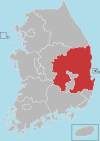
Yeongju is a city in the far north region of North Gyeongsang province in South Korea, covering 668.84 km2 with a population of 113,930 people according to the 2008 census. The city borders Bonghwa county to the east, Danyang county of North Chungcheong province to the west, Andong city and Yecheon county to the south, and Yeongwol county of Gangwon province to the north.

Danyang County is in North Chungcheong Province, South Korea.
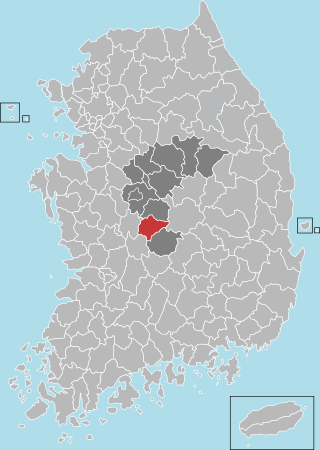
Okcheon County (Okcheon-gun) is a county in North Chungcheong Province, South Korea.
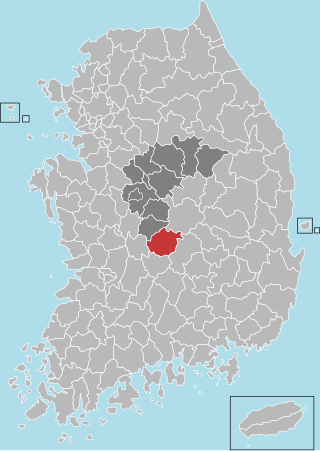
Yeongdong County (Korean: 영동군) is a county in North Chungcheong Province, South Korea. The county should not be confused with the similarly named Yeongdong region.
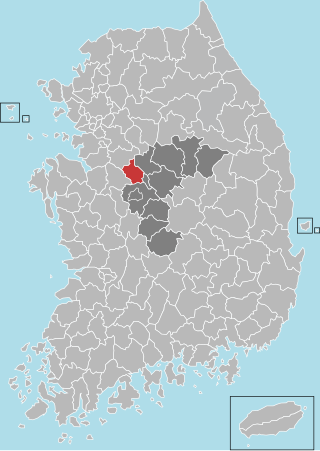
Jincheon County is a county in North Chungcheong Province Province, South Korea.

Cheongyang County is a county in South Chungcheong Province, South Korea. A predominantly rural area, it is known throughout Korea for the spicy Cheongyang chili peppers which are grown there. Another noted local specialty is the fruit of the gugija. The county is home to Cheongyang Provincial College.

Geumsan County is a county in South Chungcheong Province, South Korea. It borders Muju County, North Jeolla Province (Jeollabuk-do), which is famous for its ski resort nearby.

Yesan is a county in South Chungcheong Province, South Korea. Famous people from Yesan include independence fighter Yoon Bong-Gil.

Gimcheon is a city in North Gyeongsang Province, South Korea. It is situated on the major land transportation routes between Seoul and Busan, namely the Gyeongbu Expressway and Gyeongbu Line railway.
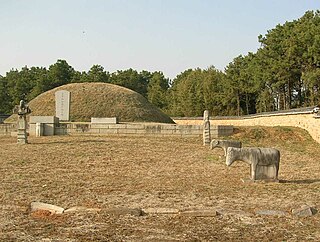
Sangju is a city in North Gyeongsang Province, central South Korea. Although Sangju is rather rural, it is very old and was once a key city. Along with Gyeongju, it gives rise to half of the name of the Gyeongsang provinces. Sangju is nicknamed Sam Baek, or "Three Whites", referring to three prominent agricultural products rice, silkworm cocoons, and dried persimmons from the area.

Bonghwa County (Bonghwa-gun) is a county in North Gyeongsang Province, South Korea. It lies inland, at the northern edge of the province, and borders Gangwon province to the north. To the east it is bounded by Yeongyang and Uljin counties, to the south by Andong, and to the west by Yeongju. The county is ringed by the Taebaek and Sobaek Mountains, the highest of which is Taebaeksan (1,566.7m). Because of its mountainous location, Bonghwa has a colder climate than most of the province, with an average annual temperature of 10 °C (50 °F).
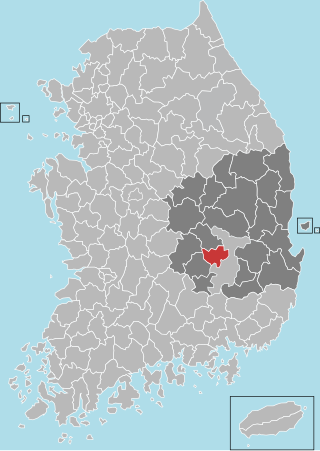
Chilgok County (Chilgok-gun) is located at south-west part of North Gyeongsang Province. It is close by Gunwi County on the east while adjoins with Gimchon-si, Seongju County on the west. It is also a transportation hub where the Nakdong river flows through and an Urban-Farming complex that adjoins with Gumi City and Daegu Metropolitan city.

Goryeong County is a county in North Gyeongsang Province, South Korea.

Gunwi County (Gunwi-gun) is a county in Daegu Metropolitan City, South Korea.

Uiseong County (Uiseong-gun) is a county in Gyeongsangbuk-do Province, South Korea. Located near the center of the province, it is bounded by Andong on the north, Cheongsong on the east, Gunwi County on the south, and Sangju and Yecheon on the west. As in most parts of Korea, most of the land is vacant and forested; only about 19% of the county's area is farmland. The county is largely rural, with an economy dominated by agriculture; the only urbanized area is the county seat, Uiseong-eup.

Yeongyang County (Yeongyang-gun) is an inland county in the north-eastern area of North Gyeongsang Province, South Korea.
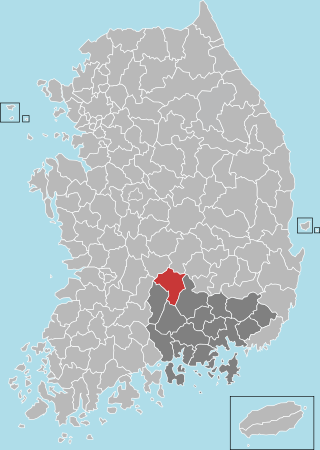
Geochang County is a county in South Gyeongsang Province, South Korea. The Geochang International Festival of Theater, which was started in 1989, is renowned as the best play festival in Korea. The District Office is located in Geochang-eup, and has jurisdiction over 1 eup and 11 myeon.

Terminal High Altitude Area Defense (THAAD), formerly Theater High Altitude Area Defense, is an American anti-ballistic missile defense system designed to shoot down short, medium, and intermediate-range ballistic missiles in their terminal phase by intercepting with a hit-to-kill approach. THAAD was developed after the experience of Iraq's Scud missile attacks during the Gulf War in 1991. The THAAD interceptor carries no warhead, instead relying on its kinetic energy of impact to destroy the incoming missile.
Chupungnyeong is a mountain pass between Yeongdong-gun, Chungcheongbuk-do and Gimcheon-si, Gyeongsangbuk-do in South Korea.

The oriental melon, is a group of Cucumis melo cultivars that are produced in East Asia. Phylogenetic studies tracing the genetic lineage of the plant suggest that it may have originated in eastern India, having then spread to China over the Silk Road, from which it was introduced to Korea and Japan. Its flavour has been described as a cross between a honeydew melon and a cucumber. It is noticeably less sweet than Western varieties of melon, and consists of about 90% water. The fruits are commonly eaten fresh; with its thin rind and small seeds, the melon can be eaten whole.























